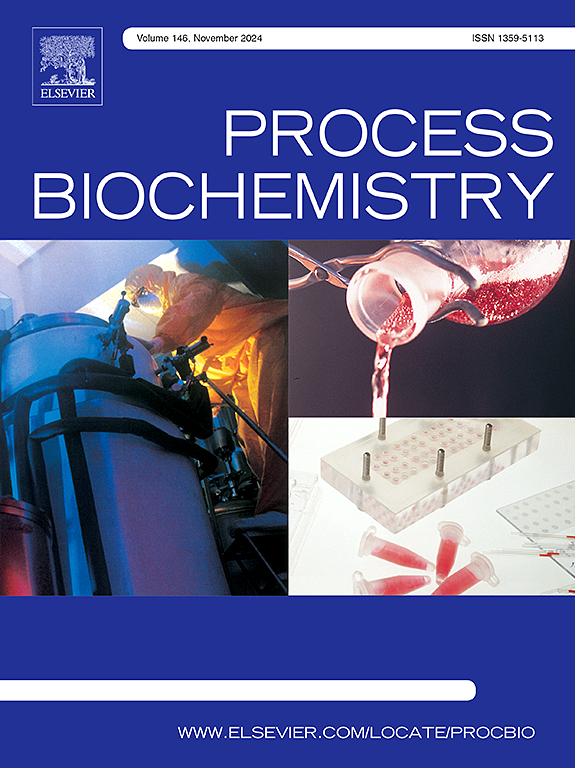In situ insertion of one or two types of hydroxy-rich noncanonical amino acids into one protein
IF 3.7
3区 生物学
Q2 BIOCHEMISTRY & MOLECULAR BIOLOGY
引用次数: 0
Abstract
Noncanonical amino acids (ncAAs) possess unique properties owing to their distinct functional groups. The predominant method for inserting ncAAs into proteins is genetic code expansion, which mimics the natural translation process and requires exogenous ncAAs supplementation. However, microbial cells often lack specific transporters for ncAAs uptake across the cell membrane and do not recognise them as essential nutrients, leading to limited insertion efficiency. To address these challenges, we developed an in situ insertion method to enhance ncAAs insertion efficiency and explored the feasibility of co-inserting two types of ncAAs into a single protein. Initially, orthogonal translation systems specific to the hydroxy-rich ncAAs 5-hydroxytryptophan (5-HTP) and 4-hydroxyisoleucine (4-HiL) were constructed and introduced into microbial cells. Subsequently, the biosynthetic pathways for 5-HTP and 4-HiL were engineered in Escherichia coli, which harboured the corresponding orthogonal translation systems. Furthermore, a co-insertion strategy was developed based on the dual use of UGA and UAG codons. In situ co-insertion of 5-HTP and 4-HiL into one protein was achieved by introducing biosynthetic pathways and orthogonal translation systems for 5-HTP and 4-HiL into the same microbial cell. These findings establish a robust framework for the precise and scalable insertion of ncAAs in advanced protein design.
将一种或两种富含羟基的非规范氨基酸原位插入到一个蛋白质中
非规范氨基酸(ncAAs)由于其不同的官能团而具有独特的性质。将ncAAs插入蛋白质的主要方法是遗传密码扩增,该方法模仿自然翻译过程,需要外源ncAAs补充。然而,微生物细胞通常缺乏特定的转运体来跨细胞膜摄取ncAAs,并且不将其识别为必需的营养物质,导致插入效率有限。为了解决这些问题,我们开发了一种原位插入方法来提高ncAAs的插入效率,并探索了将两种类型的ncAAs共同插入到单个蛋白质中的可行性。首先,构建了富羟基ncAAs 5-羟基色氨酸(5-HTP)和4-羟基异亮氨酸(4-HiL)的正交翻译体系,并将其引入微生物细胞。随后,在大肠杆菌中构建了5-HTP和4-HiL的生物合成途径,并构建了相应的正交翻译体系。此外,基于UGA和UAG密码子的双重使用,开发了一种共插入策略。通过将5-HTP和4-HiL的生物合成途径和正交翻译系统引入同一微生物细胞,实现了5-HTP和4-HiL的原位共插入。这些发现为在高级蛋白质设计中精确和可扩展地插入ncaa建立了一个强大的框架。
本文章由计算机程序翻译,如有差异,请以英文原文为准。
求助全文
约1分钟内获得全文
求助全文
来源期刊

Process Biochemistry
生物-工程:化工
CiteScore
8.30
自引率
4.50%
发文量
374
审稿时长
53 days
期刊介绍:
Process Biochemistry is an application-orientated research journal devoted to reporting advances with originality and novelty, in the science and technology of the processes involving bioactive molecules and living organisms. These processes concern the production of useful metabolites or materials, or the removal of toxic compounds using tools and methods of current biology and engineering. Its main areas of interest include novel bioprocesses and enabling technologies (such as nanobiotechnology, tissue engineering, directed evolution, metabolic engineering, systems biology, and synthetic biology) applicable in food (nutraceutical), healthcare (medical, pharmaceutical, cosmetic), energy (biofuels), environmental, and biorefinery industries and their underlying biological and engineering principles.
 求助内容:
求助内容: 应助结果提醒方式:
应助结果提醒方式:


